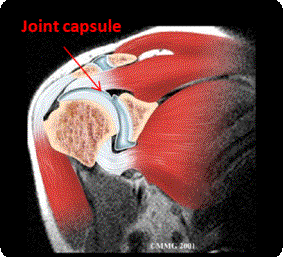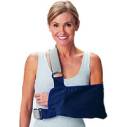Frozen Shoulder
 What is frozen shoulder?
What is frozen shoulder?
Frozen shoulder is also called capsulitis, and is thickening of the lining of the joint (capsule). The lining of the ball and socket joint is usually thin and stretchy like a rubber balloon. This allows the shoulder joint an enormous range of motion. However due to an inflammatory process this lining thickens and becomes stiff like a rubber wellington boot, resulting in a decreased range of movement. The inflammation of the joint capsule occurs in the early stages of the condition and is very painful. In the end the pain subsides and the thickened capsule consolidates with scar tissue and the loss of movement is the main feature.
Why have I got frozen shoulder?
No one knows the exact cause, there is often a history of injury to the shoulder, however if one shoulder is affected there is a good chance that the other will follow. There is an association with diabetes and frozen shoulder in these patients is more aggressive.
What are the non surgical treatment options?
Frozen shoulder is a self limiting condition and will get better on its own, but this can take several years. Physiotherapy is the mainstay of treatment to encourage and maintain movement. This is difficult during the inflammatory phase, however a steroid injection into the shoulder joint can help to reduce the inflammation or even switch the process off. Once this acutely painful phase of the condition has been superseded by stiffness; steroid injections have been shown not to help and surgery is usually required for an early resolution.
What are the operative treatments?
Capsular release: An arthroscopic release of shoulder contracture removes the thick 'wellington boot' tissue and allows the shoulder to move freely again. The body should lay down a new stretchy lining. This is key hole surgery performed through two 4 mm (¼ ") stab incisions which leaves an almost invisible scar. The surgery is done with an anaesthetic block so the arm will be numb, if you prefer you can be awake during the operation or have some sedation to make you sleepy. Because the operation uses water to see inside the joint the wounds will leak a little fluid which will be absorbed by cotton wool dressings, which are removed a few hours after surgery. You can go home the same day after seeing the physiotherapist who will give you exercises to do. (see video Capsular release)
What should I expect during recovery?
 Once the numbness has worn off (4-8 hours) the shoulder will become painful after the operation if you do not take regular pain killers as soon as you get home. Even though you may be pain free at rest you must take the tablets for when you move the shoulder as part of your rehabilitation program. A combination of regular painkillers such as paracetamol or codeine should be taken with NSAIDs (unless contra-indicated) such as ibuprofen- which is also an anti inflammatory drug. If the pain killers you have been given are not sufficient please contact your consultant's secretary or your GP. It is essential that the shoulder is kept moving straight away so that the scar tissue does not have an opportunity to reform. The little incisions are covered with a small sticky dressing which should be kept dry and replaced with spare dressings when necessary. You will be given these before leaving hospital. You will be given a sling which will protect your shoulder and help with pain relief. It must be removed for regular exercises which will be given to you by your physiotherapist. Down load physiotherapy protocol
Once the numbness has worn off (4-8 hours) the shoulder will become painful after the operation if you do not take regular pain killers as soon as you get home. Even though you may be pain free at rest you must take the tablets for when you move the shoulder as part of your rehabilitation program. A combination of regular painkillers such as paracetamol or codeine should be taken with NSAIDs (unless contra-indicated) such as ibuprofen- which is also an anti inflammatory drug. If the pain killers you have been given are not sufficient please contact your consultant's secretary or your GP. It is essential that the shoulder is kept moving straight away so that the scar tissue does not have an opportunity to reform. The little incisions are covered with a small sticky dressing which should be kept dry and replaced with spare dressings when necessary. You will be given these before leaving hospital. You will be given a sling which will protect your shoulder and help with pain relief. It must be removed for regular exercises which will be given to you by your physiotherapist. Down load physiotherapy protocol
When can I return to driving and work?
If comfortable and feel able you can return to driving at 1 week.
You can return to a sedentary job as soon as you feel able, most patients return to light manual work at 3 weeks and heavy labour at 6 weeks. Because shoulder movement is beneficial to the recovery you cannot do any damage by getting going early.
As a guide swimming and golf is 3 weeks and contact sports 6 weeks.



